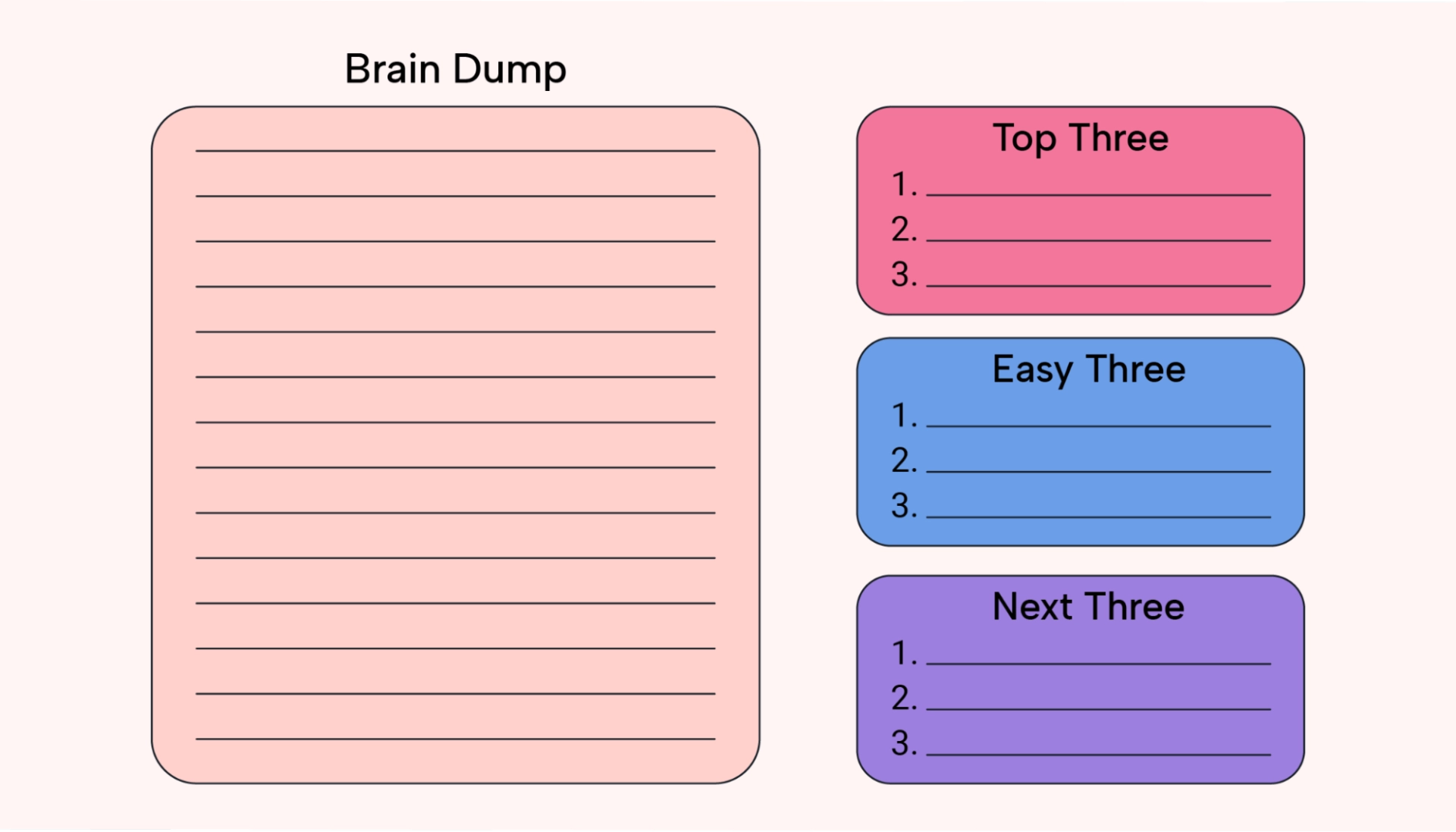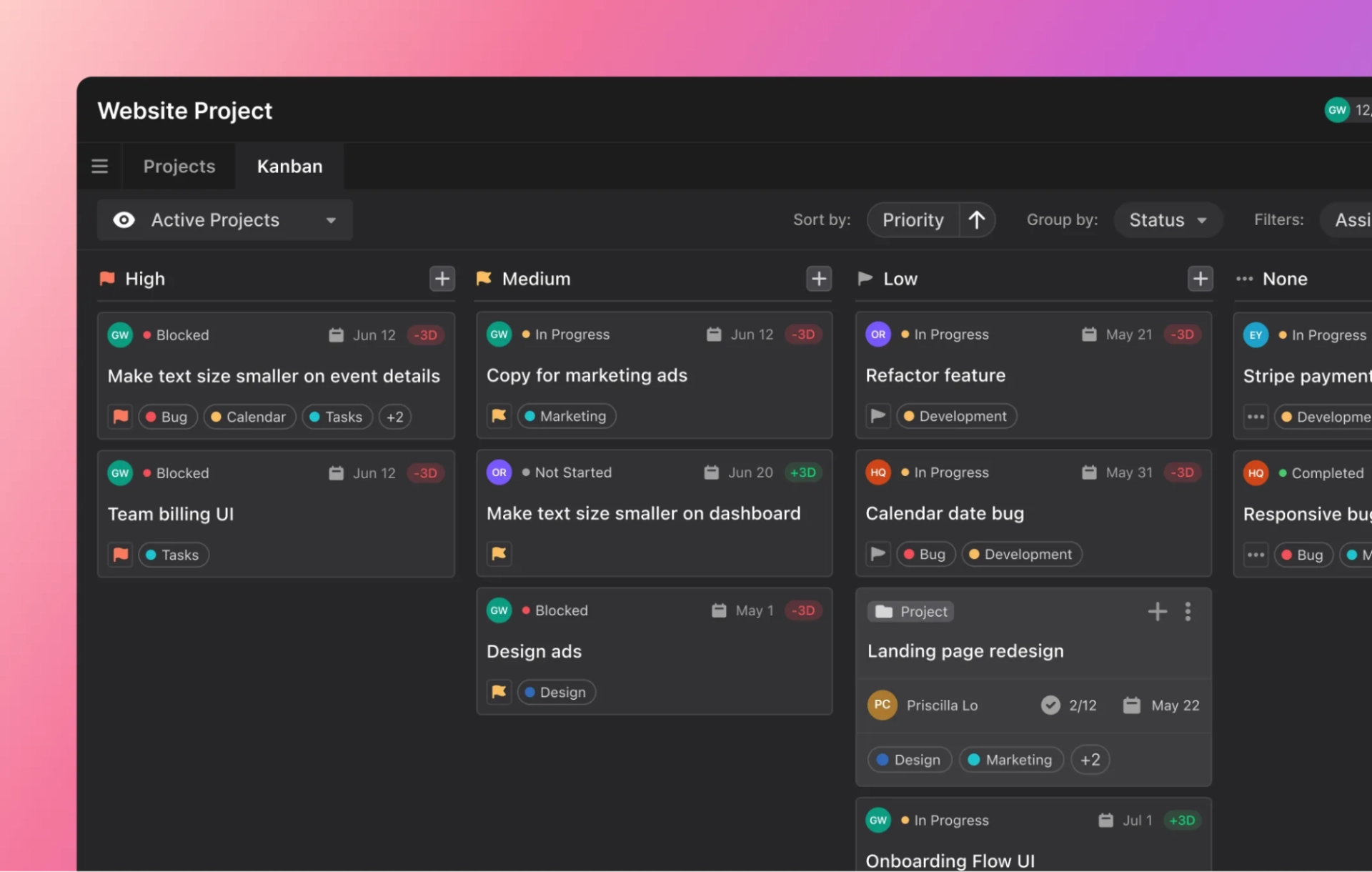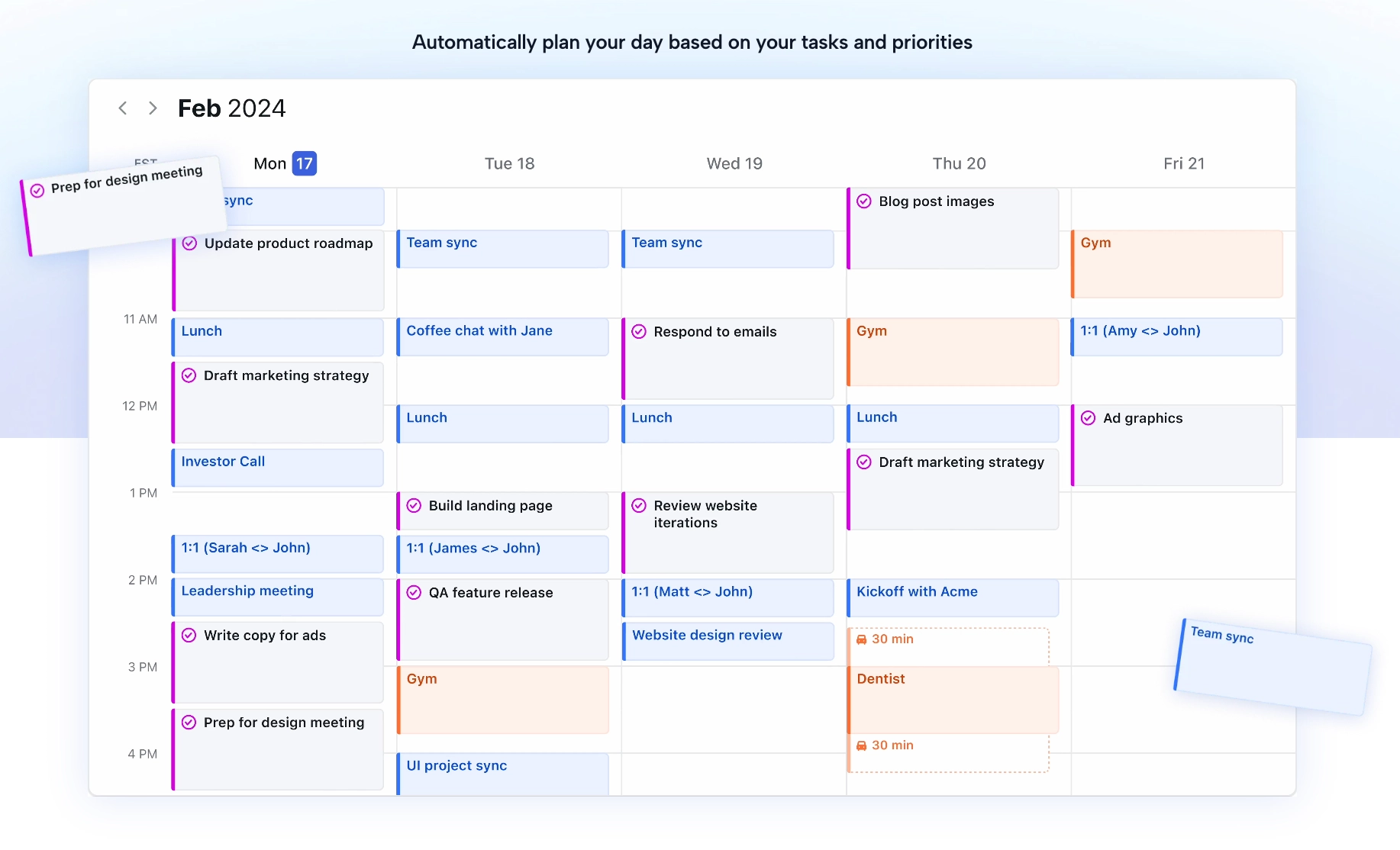Overwhelmed, stressed, and losing control? Try a brain dump. It's a quick and easy way to get everything out of your head so that you can start thinking clearly and taking action.
This article walks you through everything you need to know about brain dumps, from the how to the why.
What is a brain dump?
A brain dump is a mental decluttering tool. It refers to emptying your mind and writing down or typing up all those thoughts floating around in your head.
There are no rules with brain dumping; you just let your thoughts flow naturally, jotting down everything that comes to mind. It could be to-do lists, random worries, or creative ideas — whatever you need to get out of your head.
The goal of a brain dump is not to create a perfect piece of writing or a brilliant idea. You’re just trying to empty your headspace and gain mental clarity.
How does a brain dump work?
Our working memory — the part that juggles multiple things at once — has limits. When it's overloaded, we often feel overwhelmed and scattered.
Think of your brain as an already full cup of water — if you keep pouring more liquid in, it'll overflow. A brain dump empties the cup, giving you more room to think clearly. It also serves as an outlet to release pent-up anxiety, which, in turn, can lower stress levels and improve well-being as a whole.
Why should you do a brain dump?
If you've been feeling overwhelmed, unproductive, or just mentally checked out lately, a brain dump might just be the answer. Let’s take a look at what it can do for you.
Boost productivity and focus
When your mind is racing with a million thoughts, it's impossible to concentrate on any one task. To-dos, errands, and worries all compete for your attention.
You need a way to turn down the noise and ditch that brain tornado.
A brain dump gets these mental distractions out of the way, freeing up space for more focused work. It also helps you identify tasks or worries that aren't actually important so that you can remove them from your mental load. With a clearer head, you can assess your priorities and plan your next steps effectively.
Reduce stress and anxiety
Last year, 81% of workers reported that job stress affected their mental health.
Stress and anxiety often come from feeling like there's too much happening inside your head. A brain dump gives you back your sense of control. It stops anxious thoughts from playing in loops inside your head. The act of writing them down puts a pause on that cycle and gives your mind a well-needed break.
 |
Moreover, by dumping your thoughts onto a piece of paper, you have something concrete to tackle — a starting point to address the sources of your stress.
Improve creativity
When your creativity is clogged with worries and to-dos, it can't flow freely. A brain dump frees up mental space for new ideas. It removes those blockages so your creative thoughts can emerge naturally.
You might even see links between ideas you hadn't considered before that end up sparking inspiration. With less mental clutter, you're open to fresh perspectives and creative solutions.
Strengthen decision-making
It’s important to consider all the necessary factors when making decisions. But that can be hard to do when your mind is preoccupied with other thoughts.
By putting your thoughts down during a brain dump, you lay out all the pros, cons, and concerns impacting your decision. This visual representation helps you weigh your options more objectively.
When we’re anxious, we often make rash choices. Brain dumping also helps you separate your emotions from the decision-making process so that you can assess the situation clearly. It cuts through the mental chatter and identifies what’s most important and effective for reaching the outcome you want.
Different brain-dumping methods
There's no single "right" way to brain dump. Try out these different methods to find one that works best for your thought pattern or the specific scenario you’re facing:
The classic freewrite brain dump
The most basic method of brain dumping is the classic freewrite, where you just start writing without a specific endpoint. Include everything that comes to mind, from tasks, ideas, and random worries to emotional observations. This is a liberating way to get everything out of your head.
Choose this method when:
- You're not sure where to begin
- You need general mental decluttering
- You're feeling stuck and overwhelmed
Top 3, easy 3, next 3 brain dump
Feeling swamped with tasks? The top 3, easy 3, next 3 method can help you regain control by dividing your tasks into three categories: the Top 3 (most urgent), the Easy 3 (quick wins), and the Next 3 (for later). This system helps you with prioritization and lets you tackle your day strategically.
 |
It’s a good idea to do these categorizations at the start of your day to set priorities. For example, your Top 3 tasks might be “client report,” “urgent emails,” and “doctor's appointment.” Your Easy 3 could be “tidying your desk,” “grocery list,” and “short workout.” Your next three could be “walk dog,” “wash dishes,” and “soccer practice.”
This method is best for:
- Overcoming procrastination
- Creating momentum
- Boosting productivity in a short time
Themed brain dump
For focused problem-solving in a specific area of your life, opt for a themed brain dump. This could be based on work, a personal project, or a problem you're facing. The goal is to zero in on what's bothering you the most.
Use prompts or questions to guide your themed brain dump. For example, “What are my biggest roadblocks in [project]?" or "What emotions am I feeling about [situation]?" This focused approach helps you dig deeper so that you can gain valuable insights.
Try this method when you’re looking to:
- Dive deep into specific issues
- Solve specific problems
- Gain clarity when overwhelmed by a specific issue
Timed brain dump
For a fast mental refresh, try a timed brain dump. Set a time limit of two to five minutes, and write down everything swirling in your head during that time. A quick burst of writing is perfect for moments when your focus is scattered.
Do a timed brain dump when:
- You’re distracted in the middle of a task
- You have pre-meeting jitters
- Time is tight
How to do a brain dump
Here are the three basic steps to doing a brain dump:
1. Set the stage
Before you start dumping your thoughts, you need to find a place where you won’t be interrupted. Minimize all distractions — notifications, background noise, and clutter in your workspace.
Consider what tools work best for you. Do you prefer the traditional pen and paper or a digital note-taking app? Choose what makes you comfortable and ready to write freely.
Finally, think about your environment. Calming music or a specific scent, like a candle or essential oil, may help you focus. If you’re physically comfortable, you’ll be better able to stay mentally present throughout the writing process.
2. Let the thoughts flow
Now, it’s time to start writing down your thoughts.
When you begin the writing stage, don't overthink it. The key to successful brain dumping is to let your thoughts flow freely. Write with continuous flow, avoiding the urge to edit, correct grammar mistakes, or worry about making perfect sense.
Let your mind wander freely and follow tangents. You might be surprised where they lead. The goal is to get out of your head, so include everything and anything on your mind.
 |
Remember, there's no judgment during this phase. Embarrassing thoughts? Random doodling? Include them. Sometimes, the most unexpected things reveal the most valuable insights as you reflect later on.
3. Take a moment
After your writing session, take a break. Research shows that mini-breaks reduce mental fatigue and increase motivation to push through challenges. It's important to let your brain process what you wrote.
Briefly step back from your brain dump exercise to clear your head. Just breathe, observe your surroundings, and simply be present. Are there any immediate insights or themes jumping out at you?
That said, don't feel pressured to analyze everything right now. Deeper reflection and action planning can happen later.
5 tips to maximize your brain dumps
Here are some tips to help you make the most out of your brain dumps:
1. Don't edit as you go
Oftentimes, the most valuable stuff comes out in the rawest, unfiltered forms.
Remember, the purpose of a brain dump isn’t for you to become the next Shakespeare — it’s to clear your mind. So, while you’re writing, resist the urge to edit or censor yourself. Trying to polish your brain dump actually hinders the flow of thoughts and disrupts the process.
If staying “in the flow” doesn't feel like second nature to you, try these three tactics to train your brain:
Tactic 1: The blinding speed challenge
Set a timer for two to three minutes. Challenge yourself to write as fast as possible without even thinking about the content. The goal is to make editing during this time impossible.
Or try out The Most Dangerous Writing App, which forces you to keep writing continuously for 5 minutes, or everything disappears. It's a high-stakes way to break that editing habit.
Tactic 2: The nonsense word interruption
Pick a random word (like "kumquat"). As you write, if editing thoughts creep in, force yourself to write down the word several times before continuing with your thoughts.
Tactic 3: Draw your brain dump
If visual expression is your strong suit, you can sketch your thoughts. This removes the pressure of language entirely, letting your ideas flow freely.
2. Reflect and analyze
As you look through what you've written, start searching for patterns. Are there recurring themes? Are there certain tasks or anxieties mentioned repeatedly throughout? These could be the areas that require your attention the most. Digging deeper into them can help you identify the root causes of stress or procrastination.
Even seemingly unrelated thoughts can have a connection. These unexpected links just might turn out to be those “aha” moments you’ve been looking for.
Additionally, reflect on how you felt while you were writing. Did anger, sadness, or excitement come up? How do you feel now? Identifying strong emotions can mean you've uncovered something important to address.
3. Turn your thoughts into actions
While feeling lighter is great, a brain dump is about making real progress — moving beyond thoughts into actions.
It’s good practice to transfer the actionable items from your brain dump to a centralized place. This creates a single, organized task list, ridding you of the chaos of keeping scattered notes.
Motion lets you easily consolidate all your brain dumps and visualize your tasks in one place. See, plan, and take action on those important items that surfaced in your brain dump.
 |
Even when an item doesn’t need obvious action, ask yourself, "What's the very next thing I can do to address this?" Maybe it's more research, breaking it down into smaller steps, or delegating. This sets the wheels in motion.
4. Prioritize and categorize
Once you’ve figured out your list of action items, it’s time to determine your priorities. Use a system that makes sense to you. You could try:
- The Eisenhower Matrix (urgent/important)
- High/medium/low prioritization
- Categorizing by area (work, home, etc.).
During this process, highlight what matters most. What from your brain dump truly needs your immediate attention, and what can wait? Be honest with yourself. That way, you'll have a better idea of your next step.
Better yet, Motion automatically builds your schedule based on your tasks and priorities. You’ll always know exactly what to do next, saving you time and mental energy.
 |
5. Schedule regular brain dumps
For the best results, schedule regular brain dumps. Start with daily or weekly brain dumps, and adjust the frequency based on what works best for you. Experiment with different times of day (morning vs. night), too, to see what’s most beneficial.
The fastest way to make brain dumping stick is to pair it with an existing habit. For example, write when you have your morning coffee or while you’re commuting (though not while you’re driving, of course!). Make a conscious effort to build brain dumping into your daily routine.
Motion makes this process easy. Time block brain dumps and schedule recurring ones on our intelligent calendar to integrate this practice seamlessly into your daily life.
Motion: Your tool for mental clarity
Clear your head, and Motion will organize the rest. For maximum clarity, try Motion for free today.

Vicki Chen is a content writer and marketer using proven storytelling methods to create high-quality copy and content for SaaS companies. When she's not writing, she's spending time with Taco, her rescue dog.




